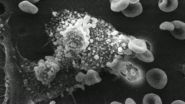(Press-News.org) Tourette syndrome is a developmental disorder characterized by involuntary, repetitive, and stereotyped movements or utterances. Now researchers reporting in the Cell Press journal Current Biology on September 25 have new evidence to explain how those with Tourette syndrome in childhood often manage to gain control over those tics. In individuals with the condition, a portion of the brain involved in planning and executing movements shows an unusual increase compared to the average brain in the production of a primary inhibitory neurotransmitter known as GABA.
The paradoxical findings—that the brains of people with Tourette syndrome produce more GABA than usual, not less—suggest that non-drug treatments that serve to increase the nerve messenger, such as brain stimulation, may speed the slow process whereby people with Tourettes naturally gain control over their disease symptoms. A major advantage of such an approach, the researchers say, is that, unlike the effect of drugs, such therapies might be targeted at the specific region where change is needed rather than the whole brain.
"In Tourette syndrome, as in many other disorders, the brain may adapt and reorganize the way it works so as to reduce or compensate for the effects of the disorder," says Stephen Jackson of the University of Nottingham. "In this case, the effects of excitatory signals that give rise to cortical hyperexcitability and unwanted movements may be compensated for by increased levels of GABA which act to 'damp-down' or reduce excitability within a localized brain area."
Jackson and his colleagues used a technique called magnetic resonance spectroscopy (MRS) to safely and noninvasively investigate levels of brain chemicals in individuals with Tourette syndrome. They were particularly interested in the amounts of GABA because of its status as the primary inhibitory neurotransmitter in the brain. They measured GABA in three brain regions—the primary motor cortex, the supplementary motor area (SMA), and a "control area" involved in visual processing—to find that people with Tourette syndrome had elevated concentrations of GABA only within the SMA.
The findings may have implications for the understanding and treatment of other neurodevelopmental conditions as well, Jackson notes, many of which are characterized by imbalances of excitatory and inhibitory influences in particular brain regions. Jackson says his team "will now explore whether this increased 'tonic' inhibition mechanism can be seen in other brain areas in Tourette syndrome, and also in other hyperactive disorders, such as obsessive compulsive disorder and autism, which are highly similar to Tourette syndrome and are often co-occurring."
INFORMATION:
Current Biology, Draper et al.: "Increased GABA contributes to enhanced control over motor excitability in Tourette syndrome."
How the brain gains control over Tourette syndrome
2014-09-25
ELSE PRESS RELEASES FROM THIS DATE:
Modified vitamin D shows promise as treatment for pancreatic cancer
2014-09-25
VIDEO:
Salk scientists find that a vitamin D-derivative makes tumors vulnerable to chemotherapy.
Click here for more information.
LA JOLLA—A synthetic derivative of vitamin D was found by Salk Institute researchers to collapse the barrier of cells shielding pancreatic tumors, making this seemingly impenetrable cancer much more susceptible to therapeutic drugs.
The discovery has led to human trials for pancreatic cancer, even in advance of its publication today in the journal ...
How physical exercise protects the brain from stress-induced depression
2014-09-25
Physical exercise has many beneficial effects on human health, including the protection from stress-induced depression. However, until now the mechanisms that mediate this protective effect have been unknown. In a new study in mice, researchers at Karolinska Institutet in Sweden show that exercise training induces changes in skeletal muscle that can purge the blood of a substance that accumulates during stress, and is harmful to the brain. The study is being published in the prestigious journal Cell.
"In neurobiological terms, we actually still don't know what depression ...
Brain chemical potential new hope in controlling Tourette Syndrome tics
2014-09-25
A chemical in the brain plays a vital role in controlling the involuntary movements and vocal tics associated with Tourette Syndrome (TS), a new study has shown.
The research by psychologists at The University of Nottingham, published in the latest edition of the journal Current Biology, could offer a potential new target for the development of more effective treatments to suppress these unwanted symptoms.
The study, led by PhD student Amelia Draper under the supervision of Professor Stephen Jackson, found that higher levels of a neurochemical called GABA in a part ...
Super enhancers in the inflamed endothelium
2014-09-25
Boston, MA – Normally, the lining of blood vessels, or endothelium, when at rest, acts like Teflon, ignoring the many cells and other factors rushing by in the bloodstream. In response to inflammatory signals, as well as other stimuli, endothelial cells change suddenly and dramatically—sending out beacons to attract inflammatory cells, changing their surface so those cells can stick and enter tissues, and initiating a complex cascade of responses essential to fighting infection and dealing with injury. Unfortunately, these same endothelial responses also promote atherosclerosis, ...
Novel compound prevents metastasis of multiple myeloma in mouse studies
2014-09-25
BOSTON –– In an advance against the problem of cancer metastasis, Dana-Farber Cancer Institute scientists have shown that a specially developed compound can impede multiple myeloma from spreading to the bones in mice. The findings, published in the Sept. 25 issue of Cell Reports, suggest the technique can protect human patients, as well, from one of the most deadly aspects of cancer.
The research involves a new approach to the challenge of cancer metastasis, the process by which tumors spread to and colonize distant parts of the body. Whereas research has traditionally ...
Dinosaur family tree gives fresh insight into rapid rise of birds
2014-09-25
The most comprehensive family tree of meat-eating dinosaurs ever created is enabling scientists to discover key details of how birds evolved from them.
The study has shown that the familiar anatomical features of birds – such as feathers, wings and wishbones – all first evolved piecemeal in their dinosaur ancestors over tens of millions of years.
However, once a fully functioning bird body shape was complete, an evolutionary explosion began, causing a rapid increase in the rate at which birds evolved. This led eventually to the thousands of avian species that we know ...
Strategic or random? How the brain chooses
2014-09-25
Many of the choices we make are informed by experiences we've had in the past. But occasionally we're better off abandoning those lessons and exploring a new situation unfettered by past experiences. Scientists at the Howard Hughes Medical Institute's Janelia Research Campus have shown that the brain can temporarily disconnect information about past experience from decision-making circuits, thereby triggering random behavior.
In the study, rats playing a game for a food reward usually acted strategically, but switched to random behavior when they confronted a particularly ...
New protein players found in key disease-related metabolic pathway
2014-09-25
CAMBRIDGE, Mass. (September 25, 2014) – To coordinate their size and growth with current environmental conditions, cells rely on the mechanistic target of rapamycin complex 1 (mTORC1) pathway, which senses cellular stresses, growth factors, and the availability of nutrients, such as amino acids and glucose.
For years, Whitehead Institute Member David Sabatini and his lab have been teasing apart the numerous proteins involved in this vital metabolic pathway, in part because mTORC1 function is known to be deregulated in a variety of diseases, including diabetes, epilepsy, ...
Large study pinpoints synapse genes with major roles in severe childhood epilepsies
2014-09-25
An international research team has identified gene mutations causing severe, difficult-to-treat forms of childhood epilepsy. Many of the mutations disrupt functioning in the synapse, the highly dynamic junction at which nerve cells communicate with one another.
"This research represents a paradigm shift in epilepsy research, giving us a new target on which to focus treatment strategies," said pediatric neurologist Dennis Dlugos, M.D., director of the Pediatric Regional Epilepsy Program at The Children's Hospital of Philadelphia, and a study co-author. "There is tremendous ...
Protein controlling gut's protective force field identified
2014-09-25
Scientists have identified a protein in the human intestine that helps to protect against attack from opportunistic bacteria that strike when our defences are down. The protein receptor is activated during illness, producing a force field on the gut's surface made of a sugary substance that encourages the growth of protective bacteria.
Scientists deleted the IL-22RA1 gene that produces the receptor protein from the mouse genome. In the absence of this gene, which is associated with inflammatory bowel disease (IBD) in humans, the mice were found to be more susceptible ...


